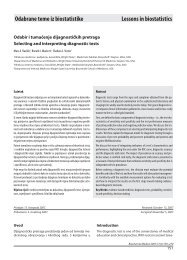Posterske teme Poster topics - Biochemia Medica
Posterske teme Poster topics - Biochemia Medica
Posterske teme Poster topics - Biochemia Medica
You also want an ePaper? Increase the reach of your titles
YUMPU automatically turns print PDFs into web optimized ePapers that Google loves.
P3-1 (UP1-1) Koagulacija<br />
simalna agregacija (V max ). U ispitivanje je bilo uključeno<br />
76 zdrave djece u dobi od 2 do 12 godina bez poremećaja<br />
hemostaze, s normalnim brojem trombocita (raspon<br />
210-425x10 9 /L) i bez uzimanja lijekova koji bi inhibirali<br />
funkciju trombocita. Referentni intervali (percentili 0,025<br />
-0,975) za induciranu agregaciju trombocita su bili za ADP<br />
68,6–92,3%, adrenalin 67,6–95,0%, kolagen 72,1–89,0% i<br />
ristocetin 79,8–98,7%. Određivanje inducirane agregacije<br />
trombocita na BCT s različitim agonistima je potpuno<br />
automatizirana i vrlo precizna analiza, izvodi se s malim<br />
volumenom plazme i standardiziranim brojem trombocita.<br />
Važan je dijagnostički parametar za utvrđivanje uzroka<br />
krvarenja, procjenu disfunkcije trombocita i utjecaja lijekova<br />
na primarnu hemostazu.<br />
E-mail: branka.paukovic-sekulic@st.htnet.hr<br />
P3-2<br />
Modifi kacija testa STA-STACLOT APC-R za<br />
dokazivanje Faktora V Leiden uporabom<br />
omjera RAPC<br />
Coen-Herak D, Miloš M, Zadro R<br />
Klinički zavod za laboratorijsku dijagnostiku, Klinički bolnički centar<br />
Zagreb, Zagreb, Hrvatska<br />
Zbog visoke učestalosti Faktora V Leiden (FVL) ispitivanje<br />
rezistencije na aktivirani protein C (RAPC) sastavni je dio<br />
analiza probiranja na trombofi liju. Pouzdani test za ispitivanje<br />
RAPC u rutinskom radu mora biti osjetljiv i specifi -<br />
čan kako bi se smanjio broj molekularnih analiza za utvrđivanje<br />
prisutnosti FVL. U testu STA-STACLOT APC-R (Diagnostika<br />
Stago, Asnieres, Francuska) uzorci se analiziraju<br />
samo u prisutnosti aktiviranog proteina C (APC), a rezultati<br />
se izražavaju kao vrijeme zgrušavanja u sekundama.<br />
Cilj ovoga rada bio je prilagoditi izvorni test STA-STACLOT<br />
APC-R za koagulacijski analizator BCT (Dade Behring), uz<br />
istodobno analiziranje uzoraka s i bez APC, te ispitati može<br />
li izražavanje rezultata kao omjer RAPC omogućiti bolje<br />
razlikovanje osoba s FVL od onih bez mutacije. U istraživanje<br />
je uključeno 353 uzoraka plazme ispitanika koji su<br />
bili upućeni u koagulacijski laboratorij zbog probiranja na<br />
trombofi liju, od kojih je bilo 171 uzoraka plazme trudnica,<br />
20 ispitanika na oralnoj antikoagulacijskoj terapiji (INRraspon:<br />
1,36-4,66) i 15 ispitanika s lupus antikoagulantom.<br />
Rezultati omjera RAPC uspoređeni su s rezultatima analize<br />
DNA za FVL. Dodatno je ispitan mogući utjecaj različitih<br />
aktivnosti proteina C (12,4-218,5%), proteina S (7,1-193,9%)<br />
i FVIII:C (96-580%) na rezultate omjera RAPC. Analizom<br />
platelet count (range 210-425x10 9 /L) and not taking any<br />
antiaggregation drugs or drugs that can cause inhibition<br />
of platelet function. The reference intervals (0.025-0.975<br />
percentiles) for induced aggregation were: ADP 68.6-<br />
92.3%, adrenaline 67.6-95.0%, collagen 72.1-89.0%, and<br />
ristocetin 79.8-98.7%. Accordingly, determination of induced<br />
platelet aggregation on BCT through aggregation<br />
inductors is a fully automated and high precision analysis.<br />
The analysis is performed on a small sample volume with<br />
standardized platelet count. Induced platelet aggregation<br />
is an important analysis for detecting the risk of bleeding,<br />
platelet dysfunction and eff ects of antiplatelet drugs on<br />
primary hemostasis.<br />
E-mail: branka.paukovic-sekulic@st.htnet.hr<br />
P3-2<br />
Coagulation<br />
Improvement of STA-STACLOT APC-R test for<br />
detection of Factor V Leiden by use of APCR<br />
ratio<br />
Coen-Herak D, Miloš M, Zadro R<br />
Clinical Institute of Laboratory Diagnosis, Zagreb University Hospital<br />
Center, Zagreb, Croatia<br />
Activated protein C resistance (APCR) has become a wellestablished<br />
part of the thrombophilia screening profi le in<br />
most laboratories due to the high frequency of Factor V<br />
Leiden (FVL). The goal of every coagulation laboratory is<br />
to fi nd a reliable screening test for the detection of activated<br />
protein C resistance (APCR) that will be suitable<br />
for routine work and that will at the same time reduce<br />
the need of genetic testing for Factor V Leiden (FVL). In<br />
the original STA-STACLOT APC-R Test (Diagnostika Stago,<br />
Asnieres, France) samples are only analyzed in the presence<br />
of APC and results are expressed as clotting time<br />
in seconds. The objectives of our study were to adapt<br />
the original STA-STACLOT APC-R Test for the BCT (Dade<br />
Behring) coagulation analyzer by testing the samples simultaneously<br />
with and without APC, and to investigate<br />
whether the expression of results as APCR ratio can better<br />
discriminate FVL carriers from non-carriers. We tested 353<br />
plasma samples from patients who were referred to our<br />
laboratory for thrombophilia screening. Among them,<br />
we analyzed plasma samples from 171 pregnant women,<br />
20 patients receiving oral anticoagulants (INR range:<br />
1.36-4.66) and 15 lupus anticoagulant positive patients.<br />
Results of APCR ratios were compared with DNA analysis<br />
<strong>Biochemia</strong> <strong>Medica</strong> 2006;16(Suppl 1):S1–S268<br />
S105






